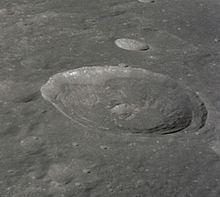Herschel (lunar crater)
This article includes a list of references, related reading, or external links, but its sources remain unclear because it lacks inline citations. (May 2024) |
 | |
| Coordinates | 5°42′S 2°06′W / 5.7°S 2.1°W |
|---|---|
| Diameter | 39 km |
| Depth | 3.8 km |
| Colongitude | 3° at sunrise |
| Eponym | William Herschel |



Herschel is a lunar impact crater located just to the north of the walled plain Ptolemaeus. Its diameter is 39 km. It was named after German-born British astronomer William Herschel.[1]
Just to the north is the flooded crater Spörer, and around 30 km due east lies the disintegrated crater Gyldén. About a crater diameter to the northwest (35 km) is the walled plain Flammarion, along the southern edge of the Sinus Medii.
The rim of this crater is generally circular, although the western side is straight. It has a well-defined edge that is not significantly worn, and the inner walls are terraced. On the rough inner floor is a notable central rise. This peak is offset slightly to the west of the crater midpoint. The small crater Herschel G is attached to the south-southwest rim, and a tiny craterlet lies across the southern rim.
Herschel is a crater of Eratosthenian age.[2]
Satellite craters
[edit]By convention these features are identified on lunar maps by placing the letter on the side of the crater midpoint that is closest to Herschel.
| Herschel | Latitude | Longitude | Diameter |
|---|---|---|---|
| C | 5.0° S | 3.2° W | 10 km |
| D | 5.3° S | 4.0° W | 20 km |
| F | 5.8° S | 4.4° W | 7 km |
| G | 6.5° S | 2.4° W | 14 km |
| H | 6.3° S | 3.4° W | 5 km |
| J | 6.4° S | 4.3° W | 5 km |
| N | 5.2° S | 1.1° W | 15 km |
| X | 5.3° S | 2.7° W | 3 km |
References
[edit]- ^ "Herschel (lunar crater)". Gazetteer of Planetary Nomenclature. USGS Astrogeology Research Program.
- ^ The geologic history of the Moon. USGS Professional Paper 1348. By Don E. Wilhelms, John F. McCauley, and Newell J. Trask. U.S. Government Printing Office, Washington: 1987. Table 12.2.
- Andersson, L. E.; Whitaker, E. A. (1982). NASA Catalogue of Lunar Nomenclature. NASA RP-1097.
- Bussey, B.; Spudis, P. (2004). The Clementine Atlas of the Moon. New York: Cambridge University Press. ISBN 978-0-521-81528-4.
- Cocks, Elijah E.; Cocks, Josiah C. (1995). Who's Who on the Moon: A Biographical Dictionary of Lunar Nomenclature. Tudor Publishers. ISBN 978-0-936389-27-1.
- McDowell, Jonathan (July 15, 2007). "Lunar Nomenclature". Jonathan's Space Report. Retrieved 2007-10-24.
- Menzel, D. H.; Minnaert, M.; Levin, B.; Dollfus, A.; Bell, B. (1971). "Report on Lunar Nomenclature by the Working Group of Commission 17 of the IAU". Space Science Reviews. 12 (2): 136–186. Bibcode:1971SSRv...12..136M. doi:10.1007/BF00171763. S2CID 122125855.
- Moore, Patrick (2001). On the Moon. Sterling Publishing Co. ISBN 978-0-304-35469-6.
- Price, Fred W. (1988). The Moon Observer's Handbook. Cambridge University Press. ISBN 978-0-521-33500-3.
- Rükl, Antonín (1990). Atlas of the Moon. Kalmbach Books. ISBN 978-0-913135-17-4.
- Webb, Rev. T. W. (1962). Celestial Objects for Common Telescopes (6th revised ed.). Dover. ISBN 978-0-486-20917-3.
- Whitaker, Ewen A. (1999). Mapping and Naming the Moon. Cambridge University Press. ISBN 978-0-521-62248-6.
- Wlasuk, Peter T. (2000). Observing the Moon. Springer. ISBN 978-1-85233-193-1.
